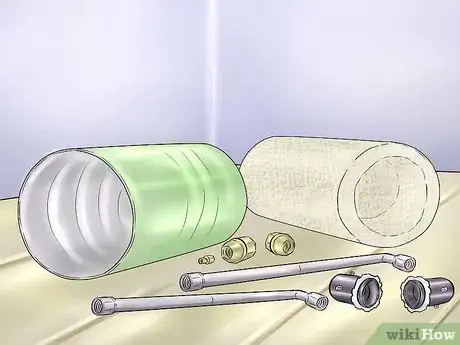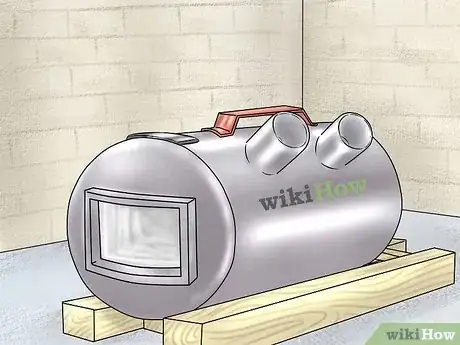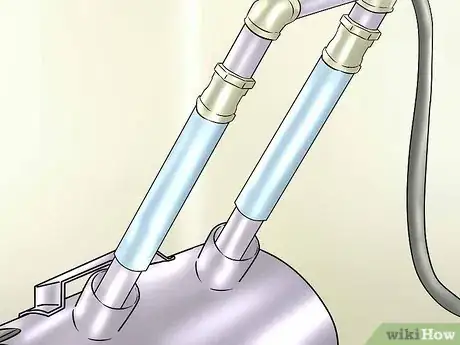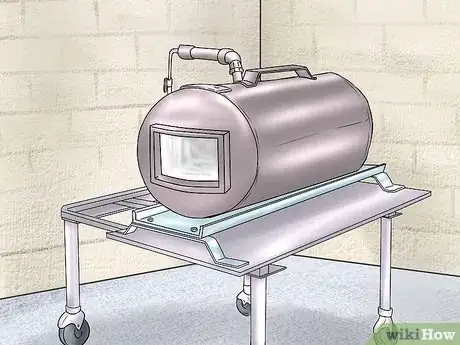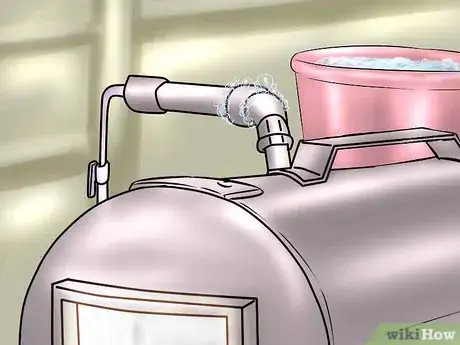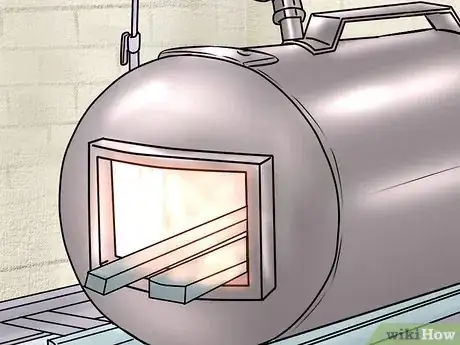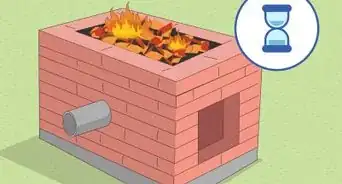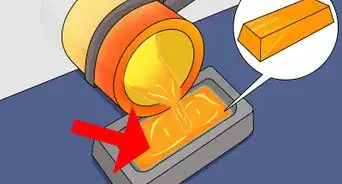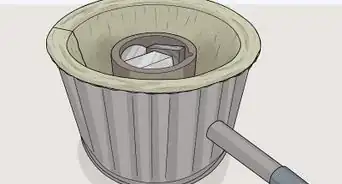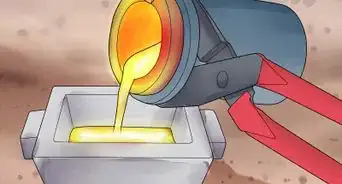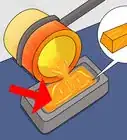wikiHow is a “wiki,” similar to Wikipedia, which means that many of our articles are co-written by multiple authors. To create this article, 9 people, some anonymous, worked to edit and improve it over time.
This article has been viewed 234,207 times.
Learn more...
In the workplace, metal is only as good as its temper. A forge allows the craftsman to change properties of metal such as its hardness, shape, and strength as a project dictates. There are several ways to accomplish this kind of metal work, but for the DIYer, a propane forge is the cleanest. This article is how to construct a general propane-fired metalworking forge for whatever your work entails.
Steps
Planning
-
1Set an objective: What is the goal of this forge? What will the end product be? Questions like this are based on what you want to make or work with, as well as the amount of use the forge.
-
2Make a tentative plan. Take the goals and decide on these factors: Number of burners, size of forge, amount of usage, budget, short-cuts (do you already have a major component of a forge?), etcetera. Where the forge will be built and operated is important (this forge must be operated outdoors).[1]Advertisement
-
3Finalize the plan. Create a parts list as based on forge design. Affirm "blueprints" as to what the forge will be, part by part, and based on size.
-
4Gather parts. This can be done progressively as you make your way building components. You can build a gas forge with a $0 budget, but you'll need to scavenge parts.
Building
-
1Build the forge body. There are two major ends of the gas forge, which are the body and the burners. The body can be any metal container such as an air tank or 5 gallon (18.9 L) paint can. This needs to be lined with an insulating layer. Firebrick is cheap but very inefficient, while high-temperature ceramic fiber blanketing is expensive and holds heat very well.[2]
-
2Set up the burners: The most practical way to build the propane burners is to buy a book. A book on homemade propane burners will offer insight on propane safety, engineering considerations, and efficiency. There are ways to make burners from mig welding tips and steel pipe, as shown above.[3]
- This picture depicts two propane burners with air chokes, mig-welding tip nozzles, and a shut-off to use just one burner.
- If budget is a major concern and your forge design is smaller than 200 cubic inches (roughly) a propane bottle torch can be used.
-
3Set-up work area. A forge stand is good if it needs to be used and moved a lot. The forge needs to be outside during operation. Properly ventilating not only the heat but the output gasses is a project on its own and doing so improperly will lead to property damage and/or death.
- The picture depicts a dolly style forge cart which holds the propane underneath with tool storage. The propane bottle is removed and place away from the forge when in use.
Testing and Operating
-
1Test the forge. Use soapy water to test whether the gas line leaks or not with pressure.[4] Use a medium-sized metal file to see how hot the forge can get and how fast it heats up. When in use, take note of how long gas lasts to budget how much work can be done on a can of propane.
-
2Use the forge.[5] Always wear safety glasses during all work. Large and hot forge work should be done with IR protective glasses. If you are a home hobbies, try these experiments:
- Use a metal file, examine the amount of sparks produced when on a bench grinder. Anneal the piece and examine again. Quench the piece in water at an orange heat and try again.
- Try making a round bar square if you have an anvil.
- Make a twist in a square bar with a vice and pliers.
- Heat a scrap metal file as hot as it can go. If it turns white and 'burns,' the forge is efficient enough to faggot-weld with. If it does not reach this temperature, it is fine.
- Try faggot-welding two rods together using borax.
Community Q&A
-
QuestionWhere do I find the liner?
 Community AnswerIf you google "kaowool" and fire clay, it will give you various resources for it. Kaowool is a fireproof insulator, so your forge holds heat. I know of forges that use firebrick, but it's a lousy insulator. Ideally you can use both; the brick for the durability (and ability to withstand the heat without breaking up), the wool and fire clay for insulation to protect your forge shell.
Community AnswerIf you google "kaowool" and fire clay, it will give you various resources for it. Kaowool is a fireproof insulator, so your forge holds heat. I know of forges that use firebrick, but it's a lousy insulator. Ideally you can use both; the brick for the durability (and ability to withstand the heat without breaking up), the wool and fire clay for insulation to protect your forge shell. -
QuestionCan the forge melt steel?
 Community AnswerIt could potentially melt the steel, if it gets hot enough.
Community AnswerIt could potentially melt the steel, if it gets hot enough. -
QuestionCan I use an old water tank to make a forge?
 Community AnswerYes; try using a tank that is 12 inches in diameter for optimal results. Using insulating wool is best.
Community AnswerYes; try using a tank that is 12 inches in diameter for optimal results. Using insulating wool is best.
Warnings
- Wear gloves when you can. Hot metal is not like hot food, it doesn't cool down as quick when in contact with skin⧼thumbs_response⧽
- Light the forge with a torch, long match, or something that gets your hands away from the opening of the forge door. Do NOT light a burner at the air choke. It will ruin your day.⧼thumbs_response⧽
- The exit gasses of a forge, propane or coal, are poisonous. You could die if the area is not well ventilated.⧼thumbs_response⧽
- Propane is explosive. You could die if you don't treat it as such.⧼thumbs_response⧽
- Always wear safety glasses for work. Metal scales when heated up, and the scale falls off when being worked with.⧼thumbs_response⧽
- Propane is poisonous. You can't breath just propane. You'll die.⧼thumbs_response⧽
References
- ↑ https://www.popularmechanics.com/home/how-to-plans/how-to/a4087/how-to-make-a-forge/
- ↑ https://www.youtube.com/watch?v=hqFDRBZZPWQ
- ↑ https://www.popsci.com/diy/article/2009-11/build-your-own-propane-forge/
- ↑ https://www.dummies.com/home-garden/home-improvement/kitchen-bath-remodeling/how-to-check-for-gas-line-leaks/
- ↑ https://www.youtube.com/watch?v=8RNVp-u10_U
About This Article
Building your own propane blacksmith forge is a great way to work with metal at home on a budget. A propane forge consists of 2 main parts, the body and the burners. You can use any metal container for the body, such as an air tank or 5-gallon paint can. Once you’ve secured your body, you’ll need to line it with an insulating layer, like firebrick or high-temperature ceramic fiber blanketing. You can make the burners from mig welding tips and steel pipe, or for a small forge, use a propane bottle torch. After you’ve set up your propane forge, test the gas lines for leaks using soapy water to make sure it’s safe. For more tips, including some fun experiments to do in your homemade forge, read on!



